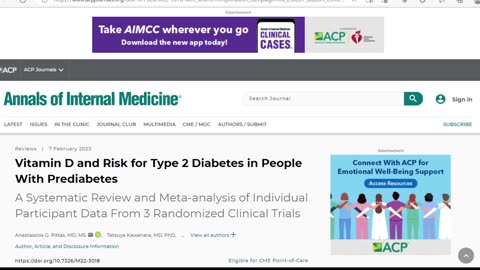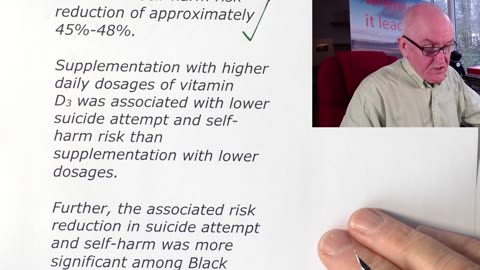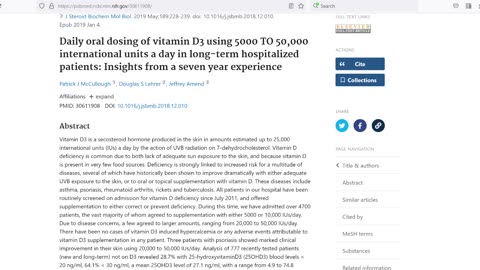
-
Vitamin D works, proof now in
 Dr. John CampbellDefinitive Evidence from Meta-Analysis and Trial Sequential Analysis https://www.ncbi.nlm.nih.gov/pmc/articles/PMC9864223/ (Italy) Various studies, a association between severe vitamin D deficiency and bad COVID-19 outcomes. Vitamin D plays a crucial role in immune function and inflammation. Recent data suggest a protective role of vitamin D against bad outcomes Nutraceutical approach Promote the immune response and reduce the inflammatory response Anti-inflammatory, antioxidant, and immunomodulatory properties of vitamin D Immune optimisation and immune boosting Vitamin D maintains pulmonary barrier function Determines the production of antimicrobial peptides Enhances neutrophil activity Shifts the adaptive immune response to a more T helper cell-2 type Anti-inflammatory effects of vitamin D Reduces the production of pro-inflammatory cytokines, such as IL-6, IL-8, IL-9, IL-12, TNF alfa, IFN gamma Increases production of anti-inflammatory cytokines, such as IL-4, IL-5, IL-10 Patients with a low baseline vitamin D, more benefit Reduce risk of asthma exacerbations Prevents acute respiratory infections, and reducing their complications COVID-19 and vitamin D (Co-VIVID study): a systematic review and meta-analysis of randomized controlled trials https://www.ncbi.nlm.nih.gov/pmc/articles/PMC8862170/ The rates of RT-CR positivity were significantly decreased in the intervention group as compared to the non-vitamin D groups (RR = 0.46) Conclusively, COVID-19 patients supplemented with vitamin D, fewer rates of ICU admission, mortality events, and RT-PCR positivity. Meta-analysis and trial sequential analysis (TSA) Better explain the strength of association Protective role of vitamin D supplementation, and risk of mortality / admission to intensive care units We searched four databases on 20 September 2022. Screened the randomized clinical trials (RCTs) Assessed the risk of bias (how to adjust thresholds for significance in randomised clinical trials when the required sample size has not been reached) The pre-specified outcomes of interest Mortality and ICU admission 78 bibliographic citations Five RCTs were suitable for our analysis Results Vitamin D administration results in a decreased risk of death, 0.49 Vitamin D administration results in a decreased risk of ICU admission, 0.28 Protective role of vitamin D and ICU admission The TSA of the protective role of vitamin D and ICU admission showed that, since the pooling of the studies reached a definite sample size, the positive association is conclusive. The studies Effects of a 2-Week 5000 IU versus 1000 IU Vitamin D3 Supplementation on Recovery of Symptoms in Patients with Mild to Moderate Covid-19: A Randomized Clinical Trial https://www.mdpi.com/2072-6643/13/7/2170 (Saudi) Effect of calcifediol treatment and best available therapy versus best available therapy on intensive care unit admission and mortality among patients hospitalized for COVID-19: A pilot randomized clinical study https://www.ncbi.nlm.nih.gov/pmc/articles/PMC7456194/ (Spain) Changes in the immune response against SARS-CoV-2 in individuals with severe COVID-19 treated with high dose of vitamin D https://www.ncbi.nlm.nih.gov/pmc/articles/PMC9008199/ (Spain) Effect of a Single High Dose of Vitamin D3 on Hospital Length of Stay in Patients With Moderate to Severe COVID-19 https://www.ncbi.nlm.nih.gov/pmc/articles/PMC7890452/ (Brazil) Calcifediol treatment and COVID-19-related outcomes https://www.ncbi.nlm.nih.gov/pmc/articles/PMC8344647/ (Spain) Medicines & Healthcare products Regulatory Agency https://www.bmj.com/content/377/bmj.o1538 86% industry funded17.5K views 265 comments
Dr. John CampbellDefinitive Evidence from Meta-Analysis and Trial Sequential Analysis https://www.ncbi.nlm.nih.gov/pmc/articles/PMC9864223/ (Italy) Various studies, a association between severe vitamin D deficiency and bad COVID-19 outcomes. Vitamin D plays a crucial role in immune function and inflammation. Recent data suggest a protective role of vitamin D against bad outcomes Nutraceutical approach Promote the immune response and reduce the inflammatory response Anti-inflammatory, antioxidant, and immunomodulatory properties of vitamin D Immune optimisation and immune boosting Vitamin D maintains pulmonary barrier function Determines the production of antimicrobial peptides Enhances neutrophil activity Shifts the adaptive immune response to a more T helper cell-2 type Anti-inflammatory effects of vitamin D Reduces the production of pro-inflammatory cytokines, such as IL-6, IL-8, IL-9, IL-12, TNF alfa, IFN gamma Increases production of anti-inflammatory cytokines, such as IL-4, IL-5, IL-10 Patients with a low baseline vitamin D, more benefit Reduce risk of asthma exacerbations Prevents acute respiratory infections, and reducing their complications COVID-19 and vitamin D (Co-VIVID study): a systematic review and meta-analysis of randomized controlled trials https://www.ncbi.nlm.nih.gov/pmc/articles/PMC8862170/ The rates of RT-CR positivity were significantly decreased in the intervention group as compared to the non-vitamin D groups (RR = 0.46) Conclusively, COVID-19 patients supplemented with vitamin D, fewer rates of ICU admission, mortality events, and RT-PCR positivity. Meta-analysis and trial sequential analysis (TSA) Better explain the strength of association Protective role of vitamin D supplementation, and risk of mortality / admission to intensive care units We searched four databases on 20 September 2022. Screened the randomized clinical trials (RCTs) Assessed the risk of bias (how to adjust thresholds for significance in randomised clinical trials when the required sample size has not been reached) The pre-specified outcomes of interest Mortality and ICU admission 78 bibliographic citations Five RCTs were suitable for our analysis Results Vitamin D administration results in a decreased risk of death, 0.49 Vitamin D administration results in a decreased risk of ICU admission, 0.28 Protective role of vitamin D and ICU admission The TSA of the protective role of vitamin D and ICU admission showed that, since the pooling of the studies reached a definite sample size, the positive association is conclusive. The studies Effects of a 2-Week 5000 IU versus 1000 IU Vitamin D3 Supplementation on Recovery of Symptoms in Patients with Mild to Moderate Covid-19: A Randomized Clinical Trial https://www.mdpi.com/2072-6643/13/7/2170 (Saudi) Effect of calcifediol treatment and best available therapy versus best available therapy on intensive care unit admission and mortality among patients hospitalized for COVID-19: A pilot randomized clinical study https://www.ncbi.nlm.nih.gov/pmc/articles/PMC7456194/ (Spain) Changes in the immune response against SARS-CoV-2 in individuals with severe COVID-19 treated with high dose of vitamin D https://www.ncbi.nlm.nih.gov/pmc/articles/PMC9008199/ (Spain) Effect of a Single High Dose of Vitamin D3 on Hospital Length of Stay in Patients With Moderate to Severe COVID-19 https://www.ncbi.nlm.nih.gov/pmc/articles/PMC7890452/ (Brazil) Calcifediol treatment and COVID-19-related outcomes https://www.ncbi.nlm.nih.gov/pmc/articles/PMC8344647/ (Spain) Medicines & Healthcare products Regulatory Agency https://www.bmj.com/content/377/bmj.o1538 86% industry funded17.5K views 265 comments -
Giving vitamin D reduced diabetes
 Dr. John CampbellVitamin D and Risk for Type 2 Diabetes in People With Prediabetes, (7th Feb 2023) https://www.acpjournals.org/doi/10.7326/M22-3018?utm_source=cmpnr&utm_campaign=lfa_230207_a&utm_content=3&cmp=1&utm_medium=email HTTPS://WWW.ACPJOURNALS.ORG/DOI/10.7326/P22-0031?UTM_SOURCE=CMPNR&UTM_CAMPAIGN=LFA_230207_A&UTM_CONTENT=3&CMP=1&UTM_MEDIUM=EMAIL Vitamin D has many functions in the body, including a role in insulin secretion and glucose metabolism. Observational studies, association between low level of vitamin D in the blood, and high risk for developing diabetes. So, does giving vitamin D to people who were at high risk for diabetes reduce the risk? Authors searched 3 databases, through 9 December 2022 Compare the use of vitamin D versus placebo for diabetes prevention, in adults with prediabetes. Meta analysis and reanalysis of pooled data Trials were at low risk for bias Results Over 3 years of follow-up Vitamin D group New-onset diabetes occurred in 22.7% Placebo group New-onset diabetes occurred in 25% Translates to being 15% reduction Number needed to treat to prevent one case of diabetes 30 adults with prediabetes to prevent 1 person from developing diabetes. Risk reduction by blood levels At least 125 nmol/L (≥50 ng/mL) group 50 to 74 nmol/L (20 to 29 ng/mL) group Cholecalciferol reduced risk for diabetes by 76% (hazard ratio, 0.24) 3-year absolute risk reduction of 18.1% Vitamin D increased the likelihood of regression to normal glucose regulation by 30% Doses used 20,000 units of cholecalciferol (vitamin D3) weekly 4000 units of cholecalciferol daily 0.75 micrograms of eldecalcitol, (synthetic analogue of vitamin D) Adverse events Rare, study could not draw any definite conclusions about safety kidney stones hypercalcemia hypercalciuria Implications In adults with prediabetes, vitamin D was effective in lowering the risk for developing diabetes. By the Numbers: Diabetes in America https://www.cdc.gov/diabetes/health-equity/diabetes-by-the-numbers.html Total Diabetes From 2001 to 2020, diabetes prevalence significantly increased among over 18s 37.3 million people have diabetes (11.3% of the US population). 28.7 million people have been diagnosed with diabetes. 8.5 million people who have diabetes have not been diagnosed (do not know they have it) Total Prediabetes 96 million US adults have prediabetes. Cost of Diabetes (2017) $327 billion, $237 billion direct medical costs $90 billion in lost productivity Excess medical costs, $9,601 per person https://www.diabetes.org.uk/professionals/position-statements-reports/statistics/diabetes-prevalence-2019 UK prevalence 4.8 million (7%) 3.9 million diagnosed 1 million undiagnosed 5.3 million by 2025 People with type 2 diabetes 50% more likely to die prematurely Two-and-a-half times more likely to. Develop heart failure Twice more likely to have a heart attack Obesity, sugars, carbohydrates, processed foods, exercise, vitamin D9.68K views 67 comments
Dr. John CampbellVitamin D and Risk for Type 2 Diabetes in People With Prediabetes, (7th Feb 2023) https://www.acpjournals.org/doi/10.7326/M22-3018?utm_source=cmpnr&utm_campaign=lfa_230207_a&utm_content=3&cmp=1&utm_medium=email HTTPS://WWW.ACPJOURNALS.ORG/DOI/10.7326/P22-0031?UTM_SOURCE=CMPNR&UTM_CAMPAIGN=LFA_230207_A&UTM_CONTENT=3&CMP=1&UTM_MEDIUM=EMAIL Vitamin D has many functions in the body, including a role in insulin secretion and glucose metabolism. Observational studies, association between low level of vitamin D in the blood, and high risk for developing diabetes. So, does giving vitamin D to people who were at high risk for diabetes reduce the risk? Authors searched 3 databases, through 9 December 2022 Compare the use of vitamin D versus placebo for diabetes prevention, in adults with prediabetes. Meta analysis and reanalysis of pooled data Trials were at low risk for bias Results Over 3 years of follow-up Vitamin D group New-onset diabetes occurred in 22.7% Placebo group New-onset diabetes occurred in 25% Translates to being 15% reduction Number needed to treat to prevent one case of diabetes 30 adults with prediabetes to prevent 1 person from developing diabetes. Risk reduction by blood levels At least 125 nmol/L (≥50 ng/mL) group 50 to 74 nmol/L (20 to 29 ng/mL) group Cholecalciferol reduced risk for diabetes by 76% (hazard ratio, 0.24) 3-year absolute risk reduction of 18.1% Vitamin D increased the likelihood of regression to normal glucose regulation by 30% Doses used 20,000 units of cholecalciferol (vitamin D3) weekly 4000 units of cholecalciferol daily 0.75 micrograms of eldecalcitol, (synthetic analogue of vitamin D) Adverse events Rare, study could not draw any definite conclusions about safety kidney stones hypercalcemia hypercalciuria Implications In adults with prediabetes, vitamin D was effective in lowering the risk for developing diabetes. By the Numbers: Diabetes in America https://www.cdc.gov/diabetes/health-equity/diabetes-by-the-numbers.html Total Diabetes From 2001 to 2020, diabetes prevalence significantly increased among over 18s 37.3 million people have diabetes (11.3% of the US population). 28.7 million people have been diagnosed with diabetes. 8.5 million people who have diabetes have not been diagnosed (do not know they have it) Total Prediabetes 96 million US adults have prediabetes. Cost of Diabetes (2017) $327 billion, $237 billion direct medical costs $90 billion in lost productivity Excess medical costs, $9,601 per person https://www.diabetes.org.uk/professionals/position-statements-reports/statistics/diabetes-prevalence-2019 UK prevalence 4.8 million (7%) 3.9 million diagnosed 1 million undiagnosed 5.3 million by 2025 People with type 2 diabetes 50% more likely to die prematurely Two-and-a-half times more likely to. Develop heart failure Twice more likely to have a heart attack Obesity, sugars, carbohydrates, processed foods, exercise, vitamin D9.68K views 67 comments -
Vitamin D reduced dementia by 40%
 Dr. John CampbellMosquito net distribution in Uganda, donations to this project, https://www.buymeacoffee.com/awmedicalvideos More videos from this project, https://www.youtube.com/channel/UCzsLklGgOttU3Se-WGLp7ow Vitamin D supplementation and incident dementia: Effects of sex, APOE, and baseline cognitive status https://alz-journals.onlinelibrary.wiley.com/doi/10.1002/dad2.12404 Alberta, Canada Known association, vitamin D deficiency, incident dementia https://nutritionj.biomedcentral.com/articles/10.1186/s12937-015-0063-7 Role of supplementation is unclear. Prospectively study Associations, vitamin D supplementation and incident dementia N = 12,388 dementia-free people (from the National Alzheimer's Coordinating Center) Methods Baseline exposure to vitamin D was considered D+ No exposure prior to dementia onset was considered D− MCI and depression were both more frequent in the D− group, compared to D+ People taking vitamin D had less MCI and less depression Adjusted for age, sex, education, race, cognitive diagnosis, depression, and apolipoprotein E (APOE) ε4. Potential interactions between exposure and model covariates were explored. Results Across all formulations, vitamin D exposure was associated with significantly longer dementia-free survival, and lower dementia incidence rate than no exposure Hazard ratio = 0.60 (95% confidence interval: 0.55–0.65) Vitamin D exposure was associated with 40% lower dementia incidence versus no exposure. Over 10 year follow up of 12,388 2,696 participants progressed to dementia Among them the 2,696 2,017 (74.8%) had no exposure to vitamin D 679 (25.2%) had baseline exposure Exposure to vitamin D was associated with significantly higher dementia-free survival 5-year survival for D− was 68.4% 5-year survival for D+ was 83.6% The effect of vitamin D on incidence rate differed significantly, Vitamin D effects were significantly greater in females versus males Vitamin D effects were significantly greater in normal cognition versus mild cognitive impairment. Vitamin D effects were significantly greater in apolipoprotein E ε4 non-carriers versus carriers. Vitamin D effects were less significantly apolipoprotein E ε4 carriers. (25% one copy, 3% two copies) Vitamin D has potential for dementia prevention, especially in the high-risk strata. Vitamin D deficiency, worldwide prevalence of up to 1 billion. https://www.sciencedirect.com/science/article/pii/S0002916523119277?via%3Dihub Mechanism of action https://www.nature.com/articles/s41430-020-0558-y Vitamin D is known to participate in the clearance of amyloid beta (Aβ) aggregates, one of the hallmarks of Alzheimer's disease (AD), and may provide neuroprotection against Aβ-induced tau hyperphosphorylation (neurofibrillary tangles) Cholecalciferol may be more effective than ergocalciferol15.8K views 72 comments
Dr. John CampbellMosquito net distribution in Uganda, donations to this project, https://www.buymeacoffee.com/awmedicalvideos More videos from this project, https://www.youtube.com/channel/UCzsLklGgOttU3Se-WGLp7ow Vitamin D supplementation and incident dementia: Effects of sex, APOE, and baseline cognitive status https://alz-journals.onlinelibrary.wiley.com/doi/10.1002/dad2.12404 Alberta, Canada Known association, vitamin D deficiency, incident dementia https://nutritionj.biomedcentral.com/articles/10.1186/s12937-015-0063-7 Role of supplementation is unclear. Prospectively study Associations, vitamin D supplementation and incident dementia N = 12,388 dementia-free people (from the National Alzheimer's Coordinating Center) Methods Baseline exposure to vitamin D was considered D+ No exposure prior to dementia onset was considered D− MCI and depression were both more frequent in the D− group, compared to D+ People taking vitamin D had less MCI and less depression Adjusted for age, sex, education, race, cognitive diagnosis, depression, and apolipoprotein E (APOE) ε4. Potential interactions between exposure and model covariates were explored. Results Across all formulations, vitamin D exposure was associated with significantly longer dementia-free survival, and lower dementia incidence rate than no exposure Hazard ratio = 0.60 (95% confidence interval: 0.55–0.65) Vitamin D exposure was associated with 40% lower dementia incidence versus no exposure. Over 10 year follow up of 12,388 2,696 participants progressed to dementia Among them the 2,696 2,017 (74.8%) had no exposure to vitamin D 679 (25.2%) had baseline exposure Exposure to vitamin D was associated with significantly higher dementia-free survival 5-year survival for D− was 68.4% 5-year survival for D+ was 83.6% The effect of vitamin D on incidence rate differed significantly, Vitamin D effects were significantly greater in females versus males Vitamin D effects were significantly greater in normal cognition versus mild cognitive impairment. Vitamin D effects were significantly greater in apolipoprotein E ε4 non-carriers versus carriers. Vitamin D effects were less significantly apolipoprotein E ε4 carriers. (25% one copy, 3% two copies) Vitamin D has potential for dementia prevention, especially in the high-risk strata. Vitamin D deficiency, worldwide prevalence of up to 1 billion. https://www.sciencedirect.com/science/article/pii/S0002916523119277?via%3Dihub Mechanism of action https://www.nature.com/articles/s41430-020-0558-y Vitamin D is known to participate in the clearance of amyloid beta (Aβ) aggregates, one of the hallmarks of Alzheimer's disease (AD), and may provide neuroprotection against Aβ-induced tau hyperphosphorylation (neurofibrillary tangles) Cholecalciferol may be more effective than ergocalciferol15.8K views 72 comments -
-
Vitamin D and prostate cancer
 Dr. John CampbellFree posters and books, https://drjohncampbell.co.uk Circulating vitamin D level and mortality in prostate cancer patients: a dose–response meta-analysis https://pubmed.ncbi.nlm.nih.gov/30352424/ Results Higher vitamin D level could reduce the risk of death among prostate cancer patients. Association of circulating 25-hydroxyvitamin D level with prognosis of prostate cancer We conducted a dose-response meta-analysis Seven eligible cohort studies, n = 7, 808 The summary HR of prostate cancer-specific mortality An increment of every 20 nmol/L in circulating vitamin D, (20 nmol/L = 8 ng/ml) HR = 0.91, (P = 0.002) Every 20 nmol/L increment in 25-hydroxyvitamin D level was associated with a 9% lower risk of, all-cause mortality, and prostate cancer-specific mortality. Pooled HRs were stable and not obviously changed by any single study. No evidence of publications bias was observed. This meta-analysis suggested that higher 25-hydroxyvitamin D level was associated with a reduction of mortality in prostate cancer patients, and vitamin D is an important protective factor in the progression and prognosis of prostate cancer. Risk estimates with 95% CI for the association between 25(OH)D and prostate cancer-specific mortality. Mechanism Vit D, could cause cell cycle arrest, and induce apoptosis, inhibiting cell proliferation in several prostate cancer cell lines Protection from prostate epithelial cell lines from oxidative stress Will supplements help? Effect of Vitamin D3 Supplements on Development of Advanced Cancer: A Secondary Analysis of the VITAL Randomized Clinical Trial https://pubmed.ncbi.nlm.nih.gov/33206192/ 4,000 units (100 micrograms) day 24 of 44 subjects (55%) showed a decrease in the number of positive cores or decrease in Gleason score Prostate cancer in black Americans https://aacrjournals.org/cancerrescommun/search-results?page=1&q=African%20American%20Prostate%20Cancer%20Displays%20Quantitatively%20Distinct%20Vitamin%20D%20Receptor&SearchSourceType=1 Cancer prevention https://www.cancer.gov/about-cancer/causes-prevention/risk/diet/vitamin-d-fact-sheet Numerous epidemiologic studies have shown that higher intake or blood levels of vitamin D are associated with a reduced risk of colorectal cancer11K views 57 comments
Dr. John CampbellFree posters and books, https://drjohncampbell.co.uk Circulating vitamin D level and mortality in prostate cancer patients: a dose–response meta-analysis https://pubmed.ncbi.nlm.nih.gov/30352424/ Results Higher vitamin D level could reduce the risk of death among prostate cancer patients. Association of circulating 25-hydroxyvitamin D level with prognosis of prostate cancer We conducted a dose-response meta-analysis Seven eligible cohort studies, n = 7, 808 The summary HR of prostate cancer-specific mortality An increment of every 20 nmol/L in circulating vitamin D, (20 nmol/L = 8 ng/ml) HR = 0.91, (P = 0.002) Every 20 nmol/L increment in 25-hydroxyvitamin D level was associated with a 9% lower risk of, all-cause mortality, and prostate cancer-specific mortality. Pooled HRs were stable and not obviously changed by any single study. No evidence of publications bias was observed. This meta-analysis suggested that higher 25-hydroxyvitamin D level was associated with a reduction of mortality in prostate cancer patients, and vitamin D is an important protective factor in the progression and prognosis of prostate cancer. Risk estimates with 95% CI for the association between 25(OH)D and prostate cancer-specific mortality. Mechanism Vit D, could cause cell cycle arrest, and induce apoptosis, inhibiting cell proliferation in several prostate cancer cell lines Protection from prostate epithelial cell lines from oxidative stress Will supplements help? Effect of Vitamin D3 Supplements on Development of Advanced Cancer: A Secondary Analysis of the VITAL Randomized Clinical Trial https://pubmed.ncbi.nlm.nih.gov/33206192/ 4,000 units (100 micrograms) day 24 of 44 subjects (55%) showed a decrease in the number of positive cores or decrease in Gleason score Prostate cancer in black Americans https://aacrjournals.org/cancerrescommun/search-results?page=1&q=African%20American%20Prostate%20Cancer%20Displays%20Quantitatively%20Distinct%20Vitamin%20D%20Receptor&SearchSourceType=1 Cancer prevention https://www.cancer.gov/about-cancer/causes-prevention/risk/diet/vitamin-d-fact-sheet Numerous epidemiologic studies have shown that higher intake or blood levels of vitamin D are associated with a reduced risk of colorectal cancer11K views 57 comments -
Vitamin D, larger doses
 Dr. John CampbellDaily oral dosing of vitamin D3 using 5000 TO 50,000 international units a day in long-term hospitalized patients: Insights from a seven year experience https://pubmed.ncbi.nlm.nih.gov/30611908/ Dayton and Cincinnati, Ohio Vitamin D3 is a hormone produced in the skin, in amounts estimated up to 25,000 international units (IUs) a day, by the action of UVB radiation Vitamin D deficiency is common, lack of adequate sun exposure to the skin, vitamin D is present in very few food sources. Deficiency is strongly linked to increased risk for a multitude of diseases, several of which have historically been shown to improve dramatically with either adequate UVB exposure to the skin, or to oral supplementation with vitamin D. These diseases include Asthma, psoriasis, rheumatoid arthritis, rickets and tuberculosis. All patients in our hospital have been routinely screened on admission for vitamin D deficiency since July 2011 Offered supplementation to either correct or prevent deficiency We have admitted over 4,700 patients (vast majority agreed to supplementation) 5000 or 10,000 IUs/day. 125 micrograms or 250 micrograms Due to disease concerns, A few agreed to 20,000 to 50,000 IUs/day. 500 micrograms to 1, 250 micrograms (1.25mg) There have been no cases of vitamin D3 induced hypercalcemia, or any adverse events attributable to vitamin D3 Three patients with psoriasis Marked clinical improvement using 20,000 to 50,000 IUs/day Analysis of 418 inpatients on D3 Long enough to develop 25OHD3 blood levels > 74.4 ng/ml, showed a mean 25OHD3 level of 118.9 ng/ml (range from 74.4 to 384.8 ng/ml) Average serum calcium level in the vit D group of 418 9.6 mg/dl Range of 8.6 to 10.7 (Normal 8.5 to 10.5) Average serum calcium level in the non vit D group of 777 Mean 25OHD3 level of 27.1 ng/ml 9.5 mg/dl Range of 8.4 to 10.7 Parathyroid hormone levels A hormone released in response to low calcium levels D3 users, 24.2 pg/ml Non D3 users, 30.2 pg/ml In summary Long-term supplementation with vitamin D3 in doses ranging from 5000 to 50,000 IUs/day appears to be safe. Conclusion Daily oral intake of vitamin D3 ranging from 5000 IU/d to 60,000 IU/d for several years was well tolerated and safe, in both our patients and staff. The mean 25OHD blood levels in our patients appear to take around 12 months to plateau on 5000 IU/d and 10,000 IU/d. The average 25OHD values Patients taking 10,000 IU/d at 12 months = 96 ng/ml Then retested at 16 months = 97 ng/ml Currently considered upper limit of normal, 100 ng/ml Conflicts of Interest The authors have no conflicts of interest to disclose. Funding This research was performed without external funding.12.5K views 108 comments
Dr. John CampbellDaily oral dosing of vitamin D3 using 5000 TO 50,000 international units a day in long-term hospitalized patients: Insights from a seven year experience https://pubmed.ncbi.nlm.nih.gov/30611908/ Dayton and Cincinnati, Ohio Vitamin D3 is a hormone produced in the skin, in amounts estimated up to 25,000 international units (IUs) a day, by the action of UVB radiation Vitamin D deficiency is common, lack of adequate sun exposure to the skin, vitamin D is present in very few food sources. Deficiency is strongly linked to increased risk for a multitude of diseases, several of which have historically been shown to improve dramatically with either adequate UVB exposure to the skin, or to oral supplementation with vitamin D. These diseases include Asthma, psoriasis, rheumatoid arthritis, rickets and tuberculosis. All patients in our hospital have been routinely screened on admission for vitamin D deficiency since July 2011 Offered supplementation to either correct or prevent deficiency We have admitted over 4,700 patients (vast majority agreed to supplementation) 5000 or 10,000 IUs/day. 125 micrograms or 250 micrograms Due to disease concerns, A few agreed to 20,000 to 50,000 IUs/day. 500 micrograms to 1, 250 micrograms (1.25mg) There have been no cases of vitamin D3 induced hypercalcemia, or any adverse events attributable to vitamin D3 Three patients with psoriasis Marked clinical improvement using 20,000 to 50,000 IUs/day Analysis of 418 inpatients on D3 Long enough to develop 25OHD3 blood levels > 74.4 ng/ml, showed a mean 25OHD3 level of 118.9 ng/ml (range from 74.4 to 384.8 ng/ml) Average serum calcium level in the vit D group of 418 9.6 mg/dl Range of 8.6 to 10.7 (Normal 8.5 to 10.5) Average serum calcium level in the non vit D group of 777 Mean 25OHD3 level of 27.1 ng/ml 9.5 mg/dl Range of 8.4 to 10.7 Parathyroid hormone levels A hormone released in response to low calcium levels D3 users, 24.2 pg/ml Non D3 users, 30.2 pg/ml In summary Long-term supplementation with vitamin D3 in doses ranging from 5000 to 50,000 IUs/day appears to be safe. Conclusion Daily oral intake of vitamin D3 ranging from 5000 IU/d to 60,000 IU/d for several years was well tolerated and safe, in both our patients and staff. The mean 25OHD blood levels in our patients appear to take around 12 months to plateau on 5000 IU/d and 10,000 IU/d. The average 25OHD values Patients taking 10,000 IU/d at 12 months = 96 ng/ml Then retested at 16 months = 97 ng/ml Currently considered upper limit of normal, 100 ng/ml Conflicts of Interest The authors have no conflicts of interest to disclose. Funding This research was performed without external funding.12.5K views 108 comments -
Vit D research, definitive and significant
 Dr. John CampbellVitamin D supplementation has a protective effect, against the incidence of COVID-19 in RCT studies, OR 0.403, (95% IC 0.218, 0.747) In the RCTs performed on HCWs, the overall reduction in risk in the population supplemented with vitamin D was approximately 80% Against the incidence of COVID-19 in analytical studies OR = 0.592, (95% IC 0.476–0.736) Against the incidence of COVID-19 ICU admission OR 0.317, (95% IC 0.147–0.680). Our meta-analysis suggests a definitive and significant association between the protective role of vitamin D and COVID-19 incidence and ICU admission. Preventive Vitamin D Supplementation and Risk for COVID-19 Infection: A Systematic Review and Meta-Analysis https://www.mdpi.com/2072-6643/16/5/679 (28th Feb 2024) Vitamin D, crucial roles Bone homeostasis, muscle function, oncogenesis, immune response and metabolism. In the context of the COVID-19 Numerous researchers have tried to determine the role vitamin D in the immune response to the virus. Systematic review and meta-analysis, 15th May 2023 Preventive vitamin D supplementation, 16 publications N = 1,262,235 participants, A protective role in Incidence of COVID-19 Mortality Admission to intensive care units (ICUs). We calculated the Odds Ratios The assessment of potential bias and the evaluation of study quality will be conducted independently by two researchers. Extra information The majority of the effects of vitamin D are mediated by the VDR, which promotes the expression of genes containing specific DNA sequences and is expressed in almost all nucleated cells Approximately 3 percent of the human genome is under the control of 1,25-dihydroxyvitamin D Vitamin D has been observed to contribute to the synthesis of defensins, to be pivotal for enhancing the phagocytic activity, and to modulate the immune system response by regulating the inflammatory cascade25.5K views 100 comments
Dr. John CampbellVitamin D supplementation has a protective effect, against the incidence of COVID-19 in RCT studies, OR 0.403, (95% IC 0.218, 0.747) In the RCTs performed on HCWs, the overall reduction in risk in the population supplemented with vitamin D was approximately 80% Against the incidence of COVID-19 in analytical studies OR = 0.592, (95% IC 0.476–0.736) Against the incidence of COVID-19 ICU admission OR 0.317, (95% IC 0.147–0.680). Our meta-analysis suggests a definitive and significant association between the protective role of vitamin D and COVID-19 incidence and ICU admission. Preventive Vitamin D Supplementation and Risk for COVID-19 Infection: A Systematic Review and Meta-Analysis https://www.mdpi.com/2072-6643/16/5/679 (28th Feb 2024) Vitamin D, crucial roles Bone homeostasis, muscle function, oncogenesis, immune response and metabolism. In the context of the COVID-19 Numerous researchers have tried to determine the role vitamin D in the immune response to the virus. Systematic review and meta-analysis, 15th May 2023 Preventive vitamin D supplementation, 16 publications N = 1,262,235 participants, A protective role in Incidence of COVID-19 Mortality Admission to intensive care units (ICUs). We calculated the Odds Ratios The assessment of potential bias and the evaluation of study quality will be conducted independently by two researchers. Extra information The majority of the effects of vitamin D are mediated by the VDR, which promotes the expression of genes containing specific DNA sequences and is expressed in almost all nucleated cells Approximately 3 percent of the human genome is under the control of 1,25-dihydroxyvitamin D Vitamin D has been observed to contribute to the synthesis of defensins, to be pivotal for enhancing the phagocytic activity, and to modulate the immune system response by regulating the inflammatory cascade25.5K views 100 comments





